Leroux-O'Connor Family site
Person Page 899

Leroux

O'Connor

Kenneth ("The Conquer") MacAlpin
M, #22451, b. 810, d. 13 February 858
Biography
- Kenneth ("The Conquer") MacAlpin was born in 810 in Iona, Argyll, Scotland+.
- He died Died from a Tumor on 13 February 858 at age ~48 in Forteviot, Strathearn, Scotland.
- He was buried after 13 February 858 at Iona Abbey in Iona, Argyll, Scotland+.
- Kenneth ("The Conquer") MacAlpin was also known as Cináed An Ferbasach.
- He was also known as Kenneth MacAlpin.
- He was also known as Kenneth, I of Scotland.
- Kenneth MacAlpin (Medieval Gaelic: Cináed mac Ailpin, Modern Scottish Gaelic: Coinneach mac Ailpein; 810 – 13 February 858) or Kenneth I was King of Dál Riada (841–850), King of the Picts (843–858), and the King of Alba (843–858). He inherited the throne of Dál Riada from his father Alpín mac Echdach, founder of the Alpínid dynasty. Kenneth I conquered the kingdom of the Picts in 843–850 and began a campaign to seize all of Scotland and assimilate the Picts, for which he was posthumously nicknamed An Ferbasach ("The Conqueror"). Forteviot (between Dunning and Perth) became the capital of his kingdom, and he also fought the Britons of the Kingdom of Strathclyde and the invading Vikings from Scandinavia. Kenneth also relocated relics including the Stone of Scone from an abandoned abbey on Iona to his new domain.
Kenneth I is traditionally considered the founder of Scotland, which was then known as Alba, although like his immediate successors, he bore the title of King of the Picts. One chronicle calls Kenneth the first Scottish lawgiver but there is no information about the laws he passed. - Áed mac Cináeda (Modern Scottish Gaelic: Aodh mac Choinnich) (died 878) was a son of Cináed mac Ailpín. He became king of the Picts in 877, when he succeeded his brother Constantín mac Cináeda. He was nicknamed Áed of the White Flowers, the wing-footed (Latin: alipes) or the white-foot (Latin: albipes).
- He held the title of King of Dál Riada from 841 to 850.
- He held the title of King of Alba from 843 to 13 February 858.
- He held the title of King of the Picts from 843 to 13 February 858.
- He is/was my 34th great-grandfather
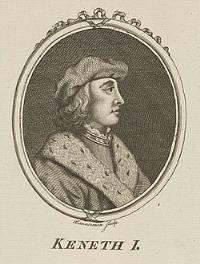
Portrait of Kenneth by Alexander Bannermann, 18th century
Family:
- [Unknown] MacAlpin+
- Máel Muire ingen Cináeda+ (d. 913)
- Causantín mac Cináeda+ (b. 836, d. 876)
- Áed mac Cináeda+ (b. after 836, d. 878)
Parents
- Father: Alpín mac Echdach (d. 20 July 834)
- Mother: [Unknown]
- Last Edited: 25 November 2021
Alpín mac Echdach
M, #22454, d. 20 July 834
Biography
- Alpín mac Echdach died on 20 July 834 in Galloway, Dumfries and Galloway, Scotland.
- Alpín mac Echdach held the title of FROM ABT 831 TO AUG 834.
- He held the title of king of Dál Riata FROM CA 831 TO AUG 834.
- Alpín mac Echdach was a supposed king of Dál Riata, an ancient kingdom that included parts of Ireland and Scotland.
Alpín was included in a pedigree chart created in the 10th century to connect the kings of Alba (Scotland) to legendary Dál Riatan and Irish ancestors. In this pedigree, Alpín's father is Eochaid, an Irish name, yet he becomes the father of Cináed (Kenneth MacAlpin) and Domnall mac Ailpín.
Cináed and Alpín are the names of Pictish kings in the 8th century: the brothers Ciniod and Elphin who ruled from 763 to 780. Alpín's alleged father Eochaid IV is not mentioned in any contemporary source.
Weir states that Alpín succeeded his father Eochaid IV as King 'of Scotland' (Dál Riata), and also became King of Kintyre in March/August 834, thus establishing his power over a wide area of Scotland. - He is/was my 35th great-grandfather
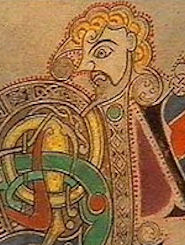
Alpin
Family: [Unknown]
- Kenneth ("The Conquer") MacAlpin+ (b. 810, d. 13 February 858)
- Domnall mac Ailpín+ (b. 812, d. 13 April 862)
- Last Edited: 9 March 2022
Domnall mac Ailpín
M, #22455, b. 812, d. 13 April 862
Biography
- Domnall mac Ailpín was born in 812.
- He died on 13 April 862 at age ~50.
- He was buried about April 862 in Iona, Argyll, Scotland+.
- Domnall mac Ailpín was also known as Donald MacAlpin.
- He was also known as Donald, I.
- The Chronicle of the Kings of Alba says that Domnall reigned for four years, matching the notices in the Annals of Ulster of his brother's death in February 858 and his own in April 862. The Chronicle notes:
In his time the Gaels with their king made the rights and laws of the kingdom, [that are called the laws] of Aed, Eochaid's son, in Forteviot.The laws of Áed Find are entirely lost, but it has been assumed that, like the laws attributed to Giric and Constantine II (Causantín mac Áeda), these related to the church and in particular to granting the privileges and immunities common elsewhere. The significance of Forteviot as the site of this law-making, along with Kenneth's death there and Constantine's later gathering at nearby Scone, may point to this as being the heartland of the sons of Alpín's support.
The Chronicle of Melrose says of Domnall, "in war he was a vigorous soldier ... he is said to have been assassinated at Scone." No other source reports Domnall's death by violence.
The Prophecy of Berchán may refer to Domnall in stanzas 123–124:
Evil will be Scotland's lot because of [the death of Kenneth MacAlpin]; long will it be till his like will come. A long while till the king takes [sovereignty], the wanton son of the foreign wife (?). He will be three years in the kingdom, and three months (although thou countest them). His tomb-stone will be above Loch Awe. He dies of disease.Although Domnall is generally supposed to have been childless, it has been suggested that Giric was a son of Domnall, reading his patronym as mac Domnaill rather than the commonly supposed mac Dúngail. This, however, is not widely accepted.
Domnall died, either at the palace of Cinnbelachoir (location unknown), or at Rathinveralmond (also unknown, and may be the same place, presumed to be near the junction of the Almond and the Tay, near Scone). He was buried on Iona. - He held the title of King of the Picts from 858 to 13 April 862.
- He is/was my 34th great-granduncle
Family:
- Giric mac Dúngail (d. about 890)
Parents
- Father: Alpín mac Echdach (d. 20 July 834)
- Mother: [Unknown]
- Last Edited: 9 March 2022
Áed mac Cináeda
M, #22456, b. after 836, d. 878
Biography
- Áed mac Cináeda was born after 836.
- He died in 878 in Strathallan, Scotland.
- He was buried in 878 in Iona, Argyll, Scotland+.
- Áed mac Cináeda was also known as Áed ("Áed of the White Flowers") mac Cináeda.
- He was also known as Aodh mac Choinnich.
- Áed mac Cináeda (Modern Scottish Gaelic: Aodh mac Choinnich; Latin: Ethus; died 878) was a son of Cináed mac Ailpín. He became king of the Picts in 877, when he succeeded his brother Constantín mac Cináeda. He was nicknamed Áed of the White Flowers, the wing-footed (Latin: alipes) or the white-foot (Latin: albipes).
- He held the title of King of the Picts between 877 and 878 in Scotland.
- He is/was my 33rd great-granduncle
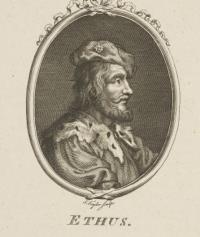
Imaginary portrait of Aed by Isaac Taylor
Family: [Unknown]
- Causantín mac Áeda+ (b. before 879, d. 952)
Parents
- Father: Kenneth ("The Conquer") MacAlpin (b. 810, d. 13 February 858)
- Last Edited: 6 March 2022
Giric mac Dúngail
M, #22457, d. about 890
Biography
- Giric mac Dúngail died about 890.
- Giric mac Dúngail (Modern Gaelic: Griogair mac Dhunghail; fl. c. 878–889), known in English simply as Giric and nicknamed Mac Rath ("Son of Fortune"), was a king of the Picts or the king of Alba. The Irish annals record nothing of Giric's reign, nor do Anglo-Saxon writings add anything, and the meagre information which survives is contradictory. Modern historians disagree as to whether Giric was sole king or ruled jointly with Eochaid, on his ancestry, and if he should be considered a Pictish king or the first king of Alba.
Although little is now known of Giric, he appears to have been regarded as an important figure in Scotland in the High Middle Ages and the Late Middle Ages. Scots chroniclers such as John of Fordun, Andrew of Wyntoun, Hector Boece and the humanist scholar George Buchanan wrote of Giric as "King Gregory the Great" and told how he had conquered half of England and Ireland too.
The Chronicle of Melrose and some versions of the Chronicle of the Kings of Alba say that Giric died at Dundurn in Strathearn. - Giric mac Dúngail held the title of King of the Picts from 878 to 889.
- He is/was my 1st cousin 35x removed
Parents
- Father: Domnall mac Ailpín (b. 812, d. 13 April 862)
- Last Edited: 22 November 2021
[Unknown] MacAlpin
F, #22458
Biography
- [Unknown] MacAlpin is/was my 33rd great-grandaunt
Family: Rhun ab Arthgal
- Eochaid ab Arthgal
Parents
- Father: Kenneth ("The Conquer") MacAlpin (b. 810, d. 13 February 858)
- Last Edited: 26 February 2022
Máel Muire ingen Cináeda
F, #22461, d. 913
Biography
- Máel Muire ingen Cináeda died in 913.
- Máel Muire ingen Cináeda is/was my 33rd great-grandaunt
Family 1: Áed mac Néill (d. 20 November 879)
- Niall Glúndub+ (d. 14 September 919)
Family 2: Flann Sinna Mac Maele Sechnaill (b. 848, d. 25 May 916)
- Lígach ingen Flann Sinna (d. 921)
- Domnall mac Flainn Sinna (d. 921)
Parents
- Father: Kenneth ("The Conquer") MacAlpin (b. 810, d. 13 February 858)
- Last Edited: 6 March 2022
Áed mac Néill
M, #22462, d. 20 November 879
Biography
- Áed mac Néill died on 20 November 879 in Druim, Louth, Ireland+.
- He was buried after 20 November 879.
- Áed mac Néill was also known as Áed Findliath.
- Áed mac Néill (died 879), called Áed Findliath ("fair-grey Áed"; Modern Irish: Aodh Fionnadhliath) to distinguish him from his paternal grandfather Áed Oirdnide, was king of Ailech and High King of Ireland. He was also called Áed Olach ("The anointing one") according to Baile in Scáil, section 51. A member of the northern Uí Néill kindred of the Cenél nEógain, Áed was the son of Niall Caille.
- He held the title of High King of Ireland from 862 to 879 in Ireland.
- He is/was my spouse of 33rd great-grandaunt
Family: Máel Muire ingen Cináeda (d. 913)
- Niall Glúndub+ (d. 14 September 919)
- Last Edited: 22 November 2021
Niall Glúndub
M, #22463, d. 14 September 919
Biography
- Niall Glúndub died on 14 September 919.
- Niall Glúndub mac Áedo (Modern Irish: Niall Glúndubh mac Aodha) (died 14 September 919) was a 10th-century Irish king of the Cenél nEógain and High King of Ireland. Many Irish kin groups were members of the Uí Néill and traced their descent from Niall of the Nine Hostages (Niall Noígiallach).
His mother was Máel Muire, daughter of Kenneth MacAlpin, King of Scots. - Niall Glúndub held the title of King of Ailech from 911 to 919 in Ireland.
- He held the title of High King of Ireland from 916 to 919.
- He is/was my 1st cousin 34x removed
Family: Gormflaith Ingen Flann Sinna Mac Aedh (d. 948)
- Muirchertach mac Néill+ (b. about 875, d. 26 March 943)
- Conaing Uí Néill, prince of Ireland+ (b. about 877, d. 937)
- Maelmuire Njalsdotter+ (b. about 880, d. 965)
Parents
- Father: Áed mac Néill (d. 20 November 879)
- Mother: Máel Muire ingen Cináeda (d. 913)
- Last Edited: 6 March 2022
[Unknown]
F, #22464
Biography
- [Unknown] is/was my spouse of 33rd great-granduncle
Family: Áed mac Cináeda (b. after 836, d. 878)
- Causantín mac Áeda+ (b. before 879, d. 952)
- Last Edited: 29 October 2021
Causantín mac Áeda
M, #22465, b. before 879, d. 952
Biography
- Causantín mac Áeda was born before 879.
- He died in 952 at Monastery of St-Andrews in St-Andrews, Fife, Scotland.
- He was buried in 952 in Iona, Argyll, Scotland+.
- Causantín mac Áeda was also known as Constantine, II of Scotland.
- He was also known as Còiseam mac Aoidh.
- Constantine, son of Áed (Medieval Gaelic: Causantín mac Áeda; Modern Gaelic: Còiseam mac Aoidh, known in most modern regnal lists as Constantine II; born no later than 879; died 952) was an early King of Scotland, known then by the Gaelic name Alba. The Kingdom of Alba, a name which first appears in Constantine's lifetime, was situated in modern-day Scotland.
The core of the kingdom was formed by the lands around the River Tay. Its southern limit was the River Forth, northwards it extended towards the Moray Firth and perhaps to Caithness, while its western limits are uncertain. Constantine's grandfather Kenneth I of Scotland (Cináed mac Ailpín, died 858) was the first of the family recorded as a king, but as king of the Picts. This change of title, from king of the Picts to king of Alba, is part of a broader transformation of Pictland and the origins of the Kingdom of Alba are traced to Constantine's lifetime.
His reign, like those of his predecessors, was dominated by the actions of Viking rulers in the British Isles, particularly the Uí Ímair ("the grandsons of Ímar", or Ivar the Boneless). During Constantine's reign the rulers of the southern kingdoms of Wessex and Mercia, later the Kingdom of England, extended their authority northwards into the disputed kingdoms of Northumbria. At first, the southern rulers allied with him against the Vikings, but in 934 Æthelstan, unprovoked, invaded Scotland both by sea and land with a huge retinue that included four Welsh Kings. He ravaged southern Alba but there is no record of any battles. He had withdrawn by September. Three years later in 937, probably in retaliation for the invasion of Alba, King Constantine allied with Olaf Guthfrithson, King of Dublin, and Owain, King of Strathclyde, but they were defeated at the battle of Brunanburh. In 943 Constantine abdicated the throne and retired to the Céli Dé (Culdee) monastery of St Andrews where he died in 952. He was succeeded by his predecessor's son Malcolm I (Máel Coluim mac Domnaill).
Constantine's reign of 43 years, exceeded in Scotland only by that of King William the Lion before the Union of the Crowns in 1603, is believed to have played a defining part in the gaelicisation of Pictland, in which his patronage of the Irish Céli Dé monastic reformers was a significant factor. During his reign the words "Scots" and "Scotland" (Old English: Scottas, Scotland) are first used to mean part of what is now Scotland. The earliest evidence for the ecclesiastical and administrative institutions which would last until the Davidian Revolution also appears at this time. - Ildulb mac Causantín, anglicised as Indulf or Indulph,[1] nicknamed An Ionsaighthigh, "the Aggressor"[2] (died 962) was king of Alba from 954 to 962. He was the son of Constantine II; his mother may have been a daughter of Earl Eadulf I of Bernicia, who was an exile in Scotland.[3]
John of Fordun and others supposed that Indulf had been king of Strathclyde in the reign of his predecessor, based on their understanding that the kingdom of Strathclyde had become a part of the kingdom of Alba in the 940s. This, however, is no longer accepted.[4]
The Chronicle of the Kings of Alba says: "In his time oppidum Eden", usually identified as Edinburgh,[5] "was evacuated, and abandoned to the Scots until the present day." This has been read as indicating that Lothian, or some large part of it, fell to Indulf at this time. However, the conquest of Lothian is likely to have been a process rather than a single event, and the frontier between the lands of the kings of Alba and Bernicia may have lain south and east of Edinburgh many years before Indulf's reign.[6]
Indulf's death is reported by the Chronicon Scotorum in 962, the Chronicle of the Kings of Alba adding that he was killed fighting Vikings near Cullen, at the Battle of Bauds. The Prophecy of Berchán, however, claims that he died "in the house of the same holy apostle, where his father [died]", that is at the céli dé monastery of St Andrews. He was buried on Iona.[7]
Indulf was succeeded by Dub (Dub mac Maíl Coluim), son of his predecessor. His sons Cuilén and Amlaíb were later kings. Eochaid, a third son, was killed with Cuilén by the men of Strathclyde in 971. - He held the title of King of Alba from 900 to 943.
- He is/was my 1st cousin 34x removed

Imaginary portrait of Constantine II
Family: [Unknown]
- Ildulb mac Causantín+ (d. 962)
- Cellach (d. 937)
- [Unknown]
Parents
- Father: Áed mac Cináeda (b. after 836, d. 878)
- Mother: [Unknown]
- Last Edited: 28 November 2021
[Unknown]
F, #22466
Biography
- Ildulb mac Causantín, anglicised as Indulf or Indulph,[1] nicknamed An Ionsaighthigh, "the Aggressor"[2] (died 962) was king of Alba from 954 to 962. He was the son of Constantine II; his mother may have been a daughter of Earl Eadulf I of Bernicia, who was an exile in Scotland.[3]
John of Fordun and others supposed that Indulf had been king of Strathclyde in the reign of his predecessor, based on their understanding that the kingdom of Strathclyde had become a part of the kingdom of Alba in the 940s. This, however, is no longer accepted.[4]
The Chronicle of the Kings of Alba says: "In his time oppidum Eden", usually identified as Edinburgh,[5] "was evacuated, and abandoned to the Scots until the present day." This has been read as indicating that Lothian, or some large part of it, fell to Indulf at this time. However, the conquest of Lothian is likely to have been a process rather than a single event, and the frontier between the lands of the kings of Alba and Bernicia may have lain south and east of Edinburgh many years before Indulf's reign.[6]
Indulf's death is reported by the Chronicon Scotorum in 962, the Chronicle of the Kings of Alba adding that he was killed fighting Vikings near Cullen, at the Battle of Bauds. The Prophecy of Berchán, however, claims that he died "in the house of the same holy apostle, where his father [died]", that is at the céli dé monastery of St Andrews. He was buried on Iona.[7]
Indulf was succeeded by Dub (Dub mac Maíl Coluim), son of his predecessor. His sons Cuilén and Amlaíb were later kings. Eochaid, a third son, was killed with Cuilén by the men of Strathclyde in 971. - [Unknown] is/was my spouse of 1st cousin 34x removed
Family: Causantín mac Áeda (b. before 879, d. 952)
- Ildulb mac Causantín+ (d. 962)
- Cellach (d. 937)
- [Unknown]
- Last Edited: 29 October 2021
Ildulb mac Causantín
M, #22467, d. 962
Biography
- Ildulb mac Causantín died in 962 in Cullen, Banffshire, Scotland.
- He was buried in 962 in Iona, Argyll, Scotland+.
- Ildulb mac Causantín was also known as Indulf mac Causantín.
- He was also known as Indulf, King of Scotland.
- Ildulb mac Causantín, anglicised as Indulf or Indulph, nicknamed An Ionsaighthigh, "the Aggressor" (died 962) was king of Alba from 954 to 962. He was the son of Constantine II; his mother may have been a daughter of Earl Eadulf I of Bernicia, who was an exile in Scotland.
John of Fordun and others supposed that Indulf had been king of Strathclyde in the reign of his predecessor, based on their understanding that the kingdom of Strathclyde had become a part of the kingdom of Alba in the 940s. This, however, is no longer accepted.
The Chronicle of the Kings of Alba says: "In his time oppidum Eden", usually identified as Edinburgh, "was evacuated, and abandoned to the Scots until the present day." This has been read as indicating that Lothian, or some large part of it, fell to Indulf at this time. However, the conquest of Lothian is likely to have been a process rather than a single event, and the frontier between the lands of the kings of Alba and Bernicia may have lain south and east of Edinburgh many years before Indulf's reign.
Indulf's death is reported by the Chronicon Scotorum in 962, the Chronicle of the Kings of Alba adding that he was killed fighting Vikings near Cullen, at the Battle of Bauds. The Prophecy of Berchán, however, claims that he died "in the house of the same holy apostle, where his father [died]", that is at the céli dé monastery of St Andrews. He was buried on Iona.
Indulf was succeeded by Dub (Dub mac Maíl Coluim), son of his predecessor. His sons Cuilén and Amlaíb were later kings. Eochaid, a third son, was killed with Cuilén by the men of Strathclyde in 971. - He held the title of King of Alba from 954 to 962.
- He is/was my 2nd cousin 33x removed
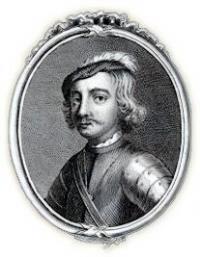
Indulf
Family: [Unknown}
- Cuilén mac Illuilb+ (d. 971)
- Amlaíb mac Illuilb (d. 977)
- Eochaid (d. 971)
Parents
- Father: Causantín mac Áeda (b. before 879, d. 952)
- Mother: [Unknown]
- Last Edited: 19 December 2021
[Unknown}
F, #22468
Biography
- [Unknown} is/was my spouse of 2nd cousin 33x removed
Family: Ildulb mac Causantín (d. 962)
- Cuilén mac Illuilb+ (d. 971)
- Amlaíb mac Illuilb (d. 977)
- Eochaid (d. 971)
- Last Edited: 29 October 2021
Cuilén mac Illuilb
M, #22469, d. 971
Biography
- Cuilén mac Illuilb died in 971.
- Cuilén mac Illuilb was also known as Cuilén, King of Scotland.
- Cuilén (also Culén, Cuilean, anglicized Colin; died 971) was an early King of Alba (Scotland). He was a son of Illulb mac Custantín, King of Alba, after whom he is known by the patronymic mac Illuilb (also mac Iduilb, mac Ilduilb etc.[note 1]) of Clann Áeda meic Cináeda, a branch of the Alpínid dynasty. During the 10th century, the Alpínids rotated the kingship of Alba between two main dynastic branches. Dub mac Maíl Choluim, a member of a rival branch of the kindred, seems to have succeeded after Illulb's death in 962. Cuilén soon after challenged him but was defeated in 965. Dub was eventually expelled and slain in 966/967. Whether Cuilén was responsible for his death is uncertain.
Following Dub's fall, Cuilén appears to have ruled as undisputed king from 966–971. Little is known of Cuilén's short reign other than his own death in 971. According to various sources, he and his brother, Eochaid, were slain by Britons. Some sources identify Cuilén's killer as Rhydderch ap Dyfnwal, a man whose daughter had been abducted and raped by the king. Rhydderch was evidently a man of eminent standing, and seems to have been a son of Dyfnwal ab Owain, King of Strathclyde, and could have possibly ruled the Cumbrian Kingdom of Strathclyde at the time of Cuilén's death.
After Cuilén's assassination, the kingship of Alba may have been assumed by another member of Clann Áeda meic Cináeda, Cináed mac Maíl Choluim, a man who appears to have launched a retaliatory raid against the Cumbrians. There is evidence indicating that Cináed faced considerable opposition from Cuilén's brother, Amlaíb, a man who was accorded the title King of Alba in Irish sources recording his death at Cináed's hands in 977. Cuilén's son, Custantín, eventually succeeded Cináed as king. There is evidence to suggest that Cuilén had another son, Máel Coluim. - He held the title of King of Alba from 966 to 971.
- He is/was my 3rd cousin 32x removed
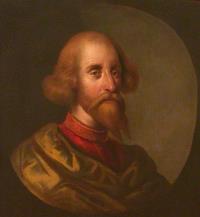
Painting of Culenus, King of Scotland. The painting is inscribed "CVLENVS. 966". The king is number 79 of de Wet's series of paintings
Family: [Unknown]
- Constantine mac Cuiléin (b. about 970, d. about 997)
Parents
- Father: Ildulb mac Causantín (d. 962)
- Mother: [Unknown}
- Last Edited: 10 March 2022
[Unknown]
F, #22470
Biography
- [Unknown] is/was my spouse of 3rd cousin 32x removed
Family: Cuilén mac Illuilb (d. 971)
- Constantine mac Cuiléin (b. about 970, d. about 997)
- Last Edited: 29 October 2021
Constantine mac Cuiléin
M, #22471, b. about 970, d. about 997
Biography
- Constantine mac Cuiléin was born about 970.
- He died about 997 at Rathinveramond in Perth, Scotland.
- Constantine mac Cuiléin was also known as Constantine, III of Scotland.
- Constantine, son of Cuilén (Mediaeval Gaelic: Causantín mac Cuiléin; Modern Gaelic: Còiseam mac Chailein), known in most modern regnal lists as Constantine III (c. 970–997), was king of Scots from 995 to 997. He was the son of King Cuilén. John of Fordun calls him, in Latin, Constantinus Calvus, which translates to Constantine the Bald. Benjamin Hudson notes that insular authors from Ireland and Scotland typically identified rulers by sobriquets, noting for example the similarly named Eugenius Calvus (Owen the Bald), an 11th-century King of Strathclyde.
- He held the title of King of Alba from 995 to 997.
- He is/was my 4th cousin 31x removed
Parents
- Father: Cuilén mac Illuilb (d. 971)
- Mother: [Unknown]
- Last Edited: 28 November 2021
Amlaíb mac Illuilb
M, #22472, d. 977
Biography
- Amlaíb mac Illuilb died in 977.
- Amlaíb mac Illuilb was also known as Amlaíb, King of Scotland.
- Amlaíb mac Illuilb (died 977) was a tenth-century King of Alba. He was one of three sons of Illulb mac Custantín, King of Alba, and a member of Clann Áeda meic Cináeda, a branch of the Alpínid dynasty. Amlaíb's paternal grandfather possessed strong connections with the Scandinavian dynasty of Dublin, and there is evidence to suggest that Illulb and Amlaíb bore names of Old Norse origin. If Amlaíb's name indeed represents a Gaelicised Scandinavian name, it could indicate that his mother was a member of the Uí Ímair, and possibly a granddaughter of Amlaíb Cúarán or Amlaíb mac Gofraid.
Following Illulb's death in 962, the kingship of Alba was taken up by Dub mac Maíl Coluim, a member of Clann Custantín meic Cináeda, a rival branch of the Alpínid dynasty. This king soon faced opposition from Amlaíb's brother, Cuilén, before the latter secured the kingship for himself in 966. Cuilén and another son of Illulb were slain in 971, after which the kingship was taken up by Dub's brother, Cináed mac Maíl Choluim. According to Irish sources, the latter slew Amlaíb in 977. The fact that these sources style Amlaíb as a king, and fail to accord a royal title to Cináed, suggests that Amlaíb was successful in seizing the kingship from his rival. - He held the title of King of Alba from 971 to 977.
- He is/was my 3rd cousin 32x removed
Parents
- Father: Ildulb mac Causantín (d. 962)
- Mother: [Unknown}
- Last Edited: 10 March 2022
Donnchad mac Máel Coluim
M, #22473, b. 1060, d. 12 November 1094
Biography
- Donnchad mac Máel Coluim was born in 1060 in Perth, Scotland.
- He died on 12 November 1094 at age ~34 at Monacheden in Kincardineshire, Scotland.
- He was buried after 12 November 1094 in Dunfermline, Fife, Scotland.
- Donnchad mac Máel Coluim was also known as Duncan, II of Scotland.
- He held the title of King of Alba in 1094 in Scotland.
- He is/was my 25th great-granduncle
Family: Ethelreda,, Queen of Scotland, (b. 1068, d. after 1090)
- William fitz Duncan (b. between 1090 and 1094, d. 1147)
Parents
- Father: Máel Coluim mac Donnchada (d. 13 November 1093)
- Mother: Ingeborg Finnsdottir (b. about 1024, d. about 1066)
- Last Edited: 29 November 2021
Étgar mac Maíl Choluim
M, #22474, b. about 1074, d. 8 January 1107
Biography
- Étgar mac Maíl Choluim was born about 1074.
- He died on 8 January 1107 in Edinburgh, Midlothian, Scotland.
- He was buried after 8 January 1107 in Dunfermline, Fife, Scotland.
- Étgar mac Maíl Choluim was also known as Edgar, King of Scotland.
- Edgar or Étgar mac Maíl Choluim (Modern Gaelic: Eagar mac Mhaoil Chaluim), nicknamed Probus, "the Valiant" (c. 1074 – 8 January 1107), was King of Scotland from 1097 to 1107. He was the fourth son of Malcolm III and Margaret of Wessex but the first to be considered eligible for the throne after the death of his father.
- He held the title of King of Alba from 1097 to 1107 in Scotland.
- He is/was my 25th great-granduncle
Parents
- Father: Máel Coluim mac Donnchada (d. 13 November 1093)
- Mother: Margaret (b. 8 September 1043, d. 16 November 1093)
- Last Edited: 17 March 2022
Dauíd mac Maíl Choluim
M, #22475, b. about 1084, d. 24 May 1153
Biography
- Dauíd mac Maíl Choluim was born about 1084 in Scotland.
- He died on 24 May 1153 in Earl Hare, Carlisle, England.
- He was buried after 24 May 1153 in Dunfermline, Fife, Scotland.
- Dauíd mac Maíl Choluim was also known as David, I of Scotland.
- He was also known as Saint David, of Scotland.
- David I or Dauíd mac Maíl Choluim (Modern: Daibhidh I mac [Mhaoil] Chaluim; c. 1084 – 24 May 1153) was a 12th-century ruler who was Prince of the Cumbrians from 1113 to 1124 and later King of Scotland from 1124 to 1153. The youngest son of Malcolm III and Margaret of Wessex, David spent most of his childhood in Scotland, but was exiled to England temporarily in 1093. Perhaps after 1100, he became a dependent at the court of King Henry I. There he was influenced by the Anglo-French culture of the court.
When David's brother Alexander I died in 1124, David chose, with the backing of Henry I, to take the Kingdom of Scotland (Alba) for himself. He was forced to engage in warfare against his rival and nephew, Máel Coluim mac Alaxandair. Subduing the latter seems to have taken David ten years, a struggle that involved the destruction of Óengus, Mormaer of Moray. David's victory allowed expansion of control over more distant regions theoretically part of his Kingdom. After the death of his former patron Henry I, David supported the claims of Henry's daughter and his own niece, Empress Matilda, to the throne of England. In the process, he came into conflict with King Stephen and was able to expand his power in northern England, despite his defeat at the Battle of the Standard in 1138. David I is a saint of the Catholic Church, with his feast day celebrated on 24 May. The term "Davidian Revolution" is used by many scholars to summarise the changes which took place in Scotland during his reign. These included his foundation of burghs and regional markets, implementation of the ideals of Gregorian Reform, foundation of monasteries, Normanisation of the Scottish government, and the introduction of feudalism through immigrant French and Anglo-French knights. - He held the title of Earl of Huntingdon from 1113 to 1124.
- He held the title of Prince of the Cumbrians from 1113 to 1124.
- He was crowned in 1124 in Scone, Perth, Scotland.
- He held the title of King of Scotland from April 1124 to 24 May 1153.
- He is/was my 25th great-grandfather
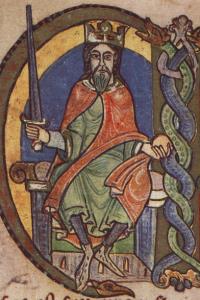
Detail from the charter of Malcolm IV, King of Scotland to Kelso Abbey showing an illustration of David I, King of Scotland.
Family: Maud, of Huntingdon, Queen of Scotland, (b. February 1072, d. 23 April 1131)
- Malcolm of Scotland (b. 1113, d. 1113)
- Henry Of Scotland+ (b. 19 November 1114, d. 12 June 1152)
- Clarice, of Scotland (b. about 1115)
Parents
- Father: Máel Coluim mac Donnchada (d. 13 November 1093)
- Mother: Margaret (b. 8 September 1043, d. 16 November 1093)
- Last Edited: 8 March 2022